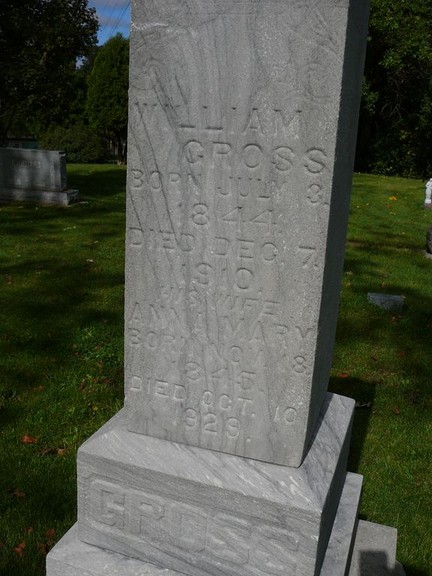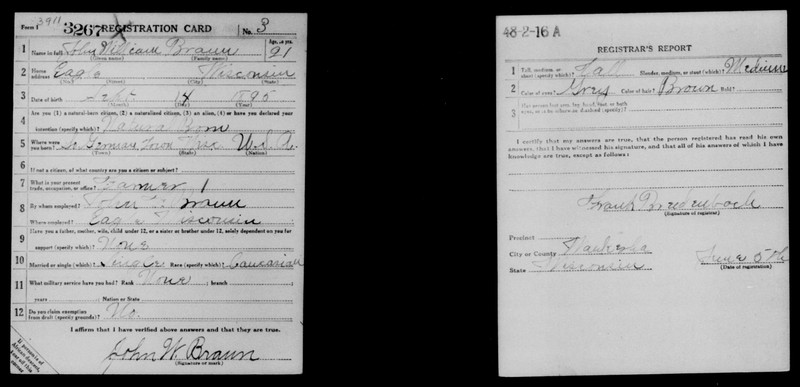John W. Braun: Wisconsin Farm Boy
Introduction
Text-to-speech Audio
Images
The grave of John's Grandfather, William Gross, at Saint Anthony Catholic Church in Menomonee Falls, Wisconsin.

John W. Braun World War 1 Draft Card

John W. Braun Draft Registration Card

Backstory and Context
Text-to-speech Audio
John William Braun was born September 14, 1895, in South Germantown, Wisconsin. He grew up Catholic and lived with his parents John Frank Braun and Annie Marie Braun (née Gross). John spent the early years of his life in South Germantown, Wisconsin. In 1902 his father, John F. Braun purchased the family farm on 160 acres in Eagle, Wisconsin and in 1905 he purchased an additional 80 acres to add to the farm.
John spent the rest of his youth on the farm with his fourteen siblings, he was the fourth born. Large families were common in rural areas as farms depended on family labor. John received an eighth grade education which was typical for the time especially in rural areas. Many rural families believed that working on the farm allowed children to connect with nature and develop family relationships. His father, John F. Braun was a member of the Waukesha County Guernsey Breeders Association as well as the Wisconsin Agricultural Experiment Association.
On the farm they practiced general farming, stock raising and dairy. They had about 30 dairy cattle and between 60 and 70 hogs per annum. Living and working on a dairy farm John would rise early to milk the cows in the “cow yard” and feed the cows and hogs. Tending to cattle took a great deal of time and commitment to ensure healthy cows while making a profit. Crop raising was an important job on the farm and required hard labor and dedication but was essential to raising healthy animals and turning a profit. John spent his days outside tending to the crops and experimenting with different soils and conditions to find more productive methods of farming, an important part of the Wisconsin Agricultural Experiment Associations mission.
John, like most Wisconsin farmers, saw drastic changes in agriculture with the start of World War 1. When America declared war in 1917 food became a vital part of the war effort. Agricultural productivity and greater yields became important aspects in American agriculture. This discouraged many Wisconsin farmers as 1917 saw a disappointing wheat harvest and farmers began to feel the economic and governmental pressures. The war put stress on farmers as increased agricultural production caused prices to fall and farmers felt the pressure to fulfil their patriotic duty. As a result of the economic hardships faced during the war, farmers turned to more scientific means of farming, something John and his father had already experimented with. Crossbreeding for stronger animals and hybrid crops became more prominent throughout Wisconsin. Institutions such as the College of Agriculture developed and examined new techniques to improve agricultural productivity. Farmers no longer focused on "textbook" farming instead, they experimented.
Despite the need for farmers, John entered military service at age 22 on August 7, 1918, in Waukesha, Wisconsin as a member of Battery E 138th Field Artillery. John was not the first member of his family to join the military. His grandfather fought in the Civil War as a member of the 26th Wisconsin Infantry where he was wounded in the leg and scalp. John trained at Camp Shelby in Mississippi and shipped out to England on October 5, 1928. The journey to England lasted around twelve days and it was difficult. Most men were sea sick and vomiting all over the ship. On top of that there was the constant threat of a German submarine or U-boat attack. Unfortunately, shorty after arriving in England, on October 20, 1918, John died of pneumonia at Belmont Road Hospital in Liverpool, Lancashire, England, United Kingdom. It is likely that he contracted pneumonia on the ship given the close contact with others. He was only 23 years old at the time of his death. He died just fifteen days after leaving the United States and never made it into combat.
Sources
Apps, Jerry. Wisconsin Agriculture: A History. Madison: Wisconsin Historical Society Press, 2015.
Birk, Amanda, Fostering on the Farm: Child Placement in the Rural Midwest. Champain: University of Illinois Press, 2015. https://ebookcentral-proquest-com.pioproxy.carrollu.edu/lib/carrolluniv/detail.action?docID=3440672.
Findagave.com. Accessed March 6, 2020. https://www.findagrave.com/memorial/25584195/william-gross.
Geo. A. Ogle and Co. Map of Eagle Township. 1914. “Historical Map Works Residential Genealogy.” http://www.historicmapworks.com/Map/US/41652/Eagle+Township/Waukesha+County+1914/Wisconsin/ (accessed March 7, 2020).
Glad, Paul W., The History of Wisconsin: War, a New Era, and Depression, 1914-1940. Madison: Wisconsin Historical Society, 1990. https://ebookcentral-proquest-com.pioproxy.carrollu.edu/lib/carrolluniv/detail.action?docID=3417366.
Haight, Theron. Memoirs of Waukesha County. Madison: Western Historical Association, 1907.
Janus, Edward, Creating Dairyland: How Caring for Cows Saved Our Soil, Created Our Landscape, Brought Prosperity to Our State, and Still Shapes Our Way of Life in Wisconsin. Madison: Wisconsin Historical Society, 2011. https://ebookcentral-proquest-com.pioproxy.carrollu.edu/lib/carrolluniv/detail.action?docID=3417319 .
Moore, R.A. “Membership-1913.” Eleventh Annual Report of the Wisconsin Agricultural Experiment Association Annual Meeting, no. 11 (1913): 111, accessed March 5, 2020, http://digicoll.library.wisc.edu/cgi-bin/WI/WI-idx?type=header&id=WI.AEA1913.
Powell, Allan. Nels Anderson’s World War I Diary. Salt Lake City: The University of Utah Press, 2013.
Schafer, Joseph. A History of Agriculture in Wisconsin. Des Moines: Homestead Printing Company, 1922.
Waukesha County War History. Military Service Record. John W. Braun.
https://www.findagrave.com/memorial/25584195/william-gross/photo
Author
https://www.familysearch.org/ark:/61903/1:1:K874-48M
